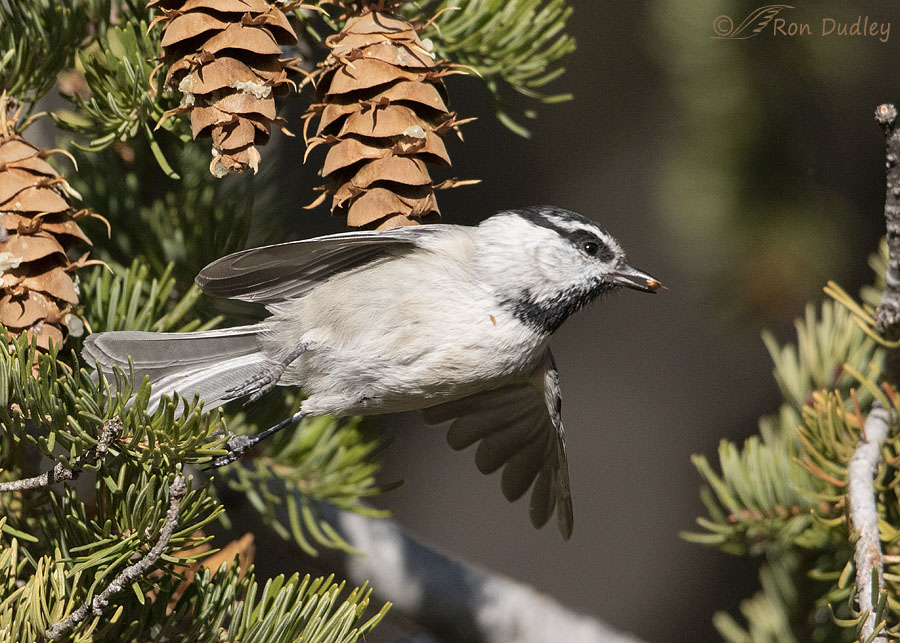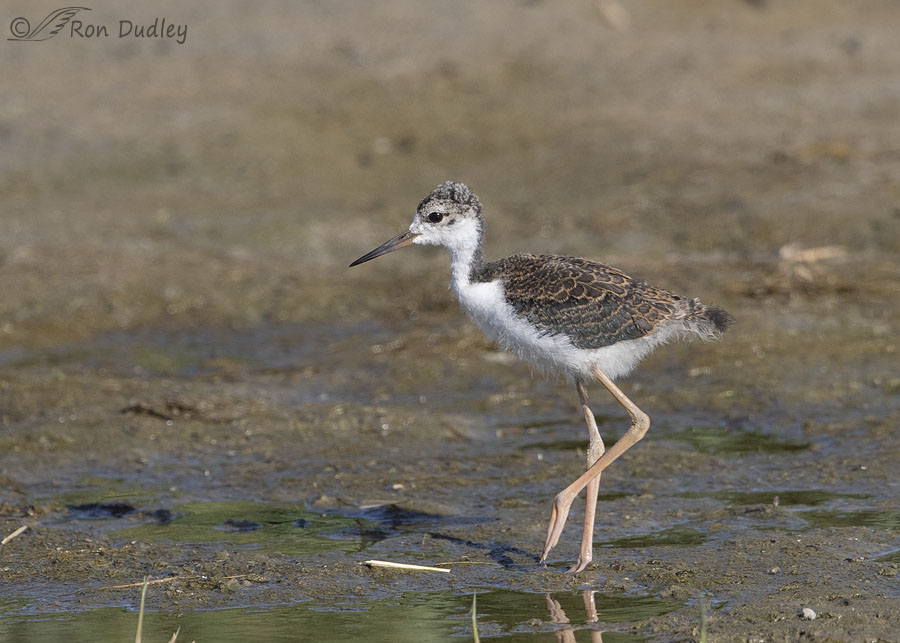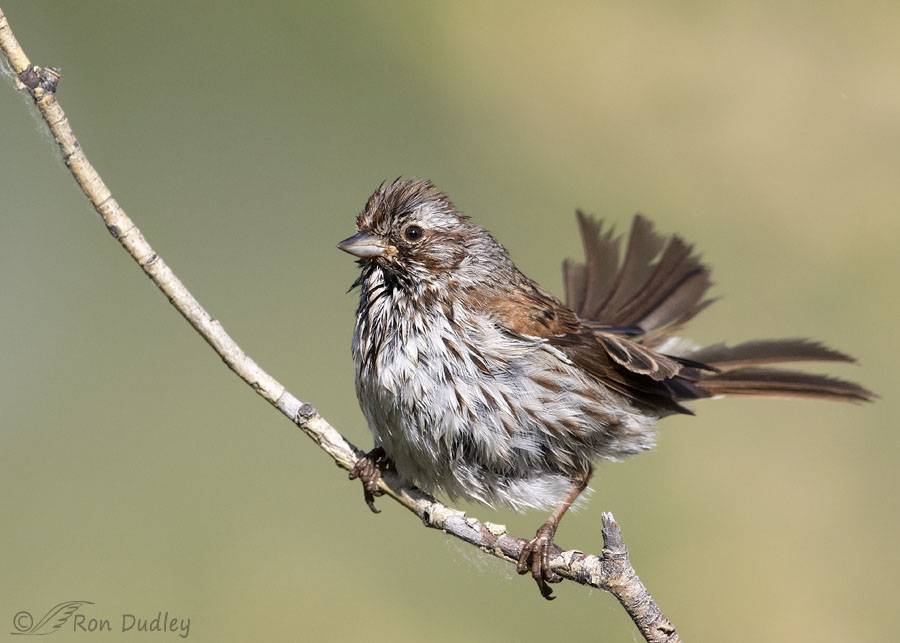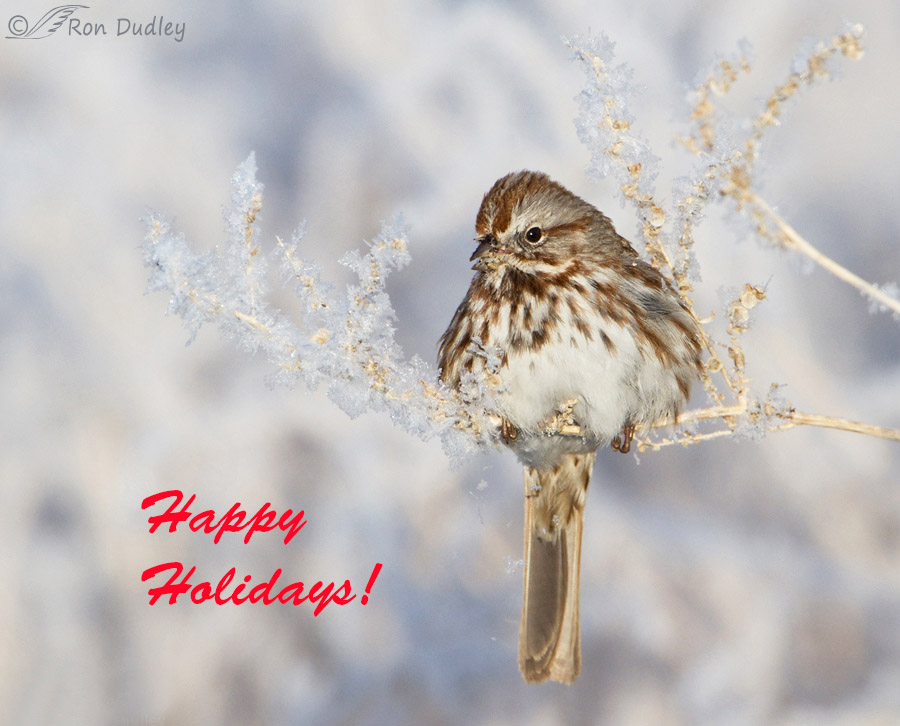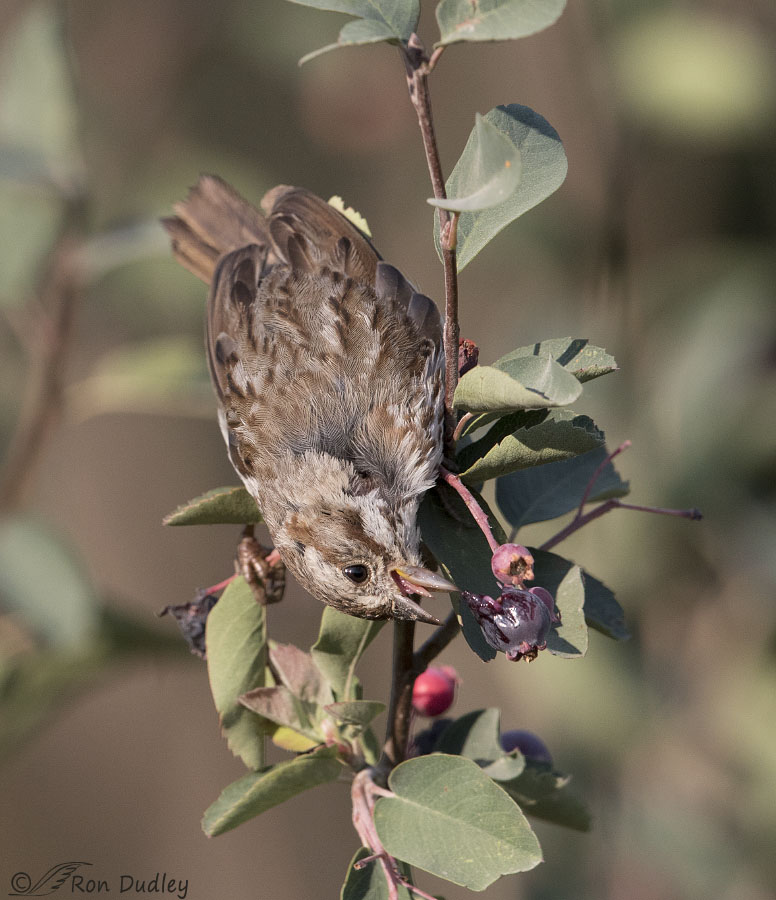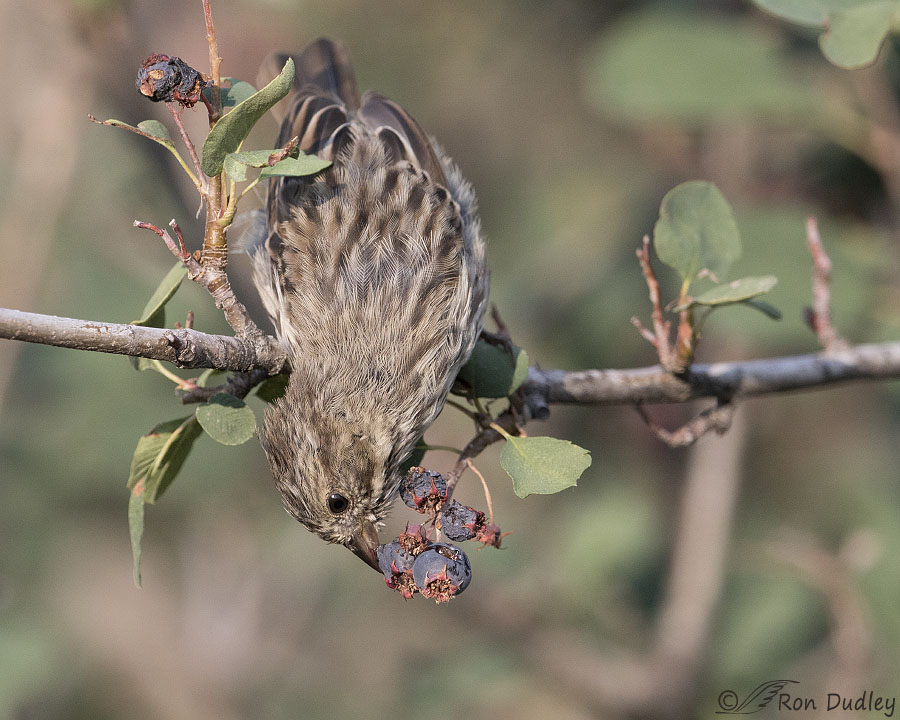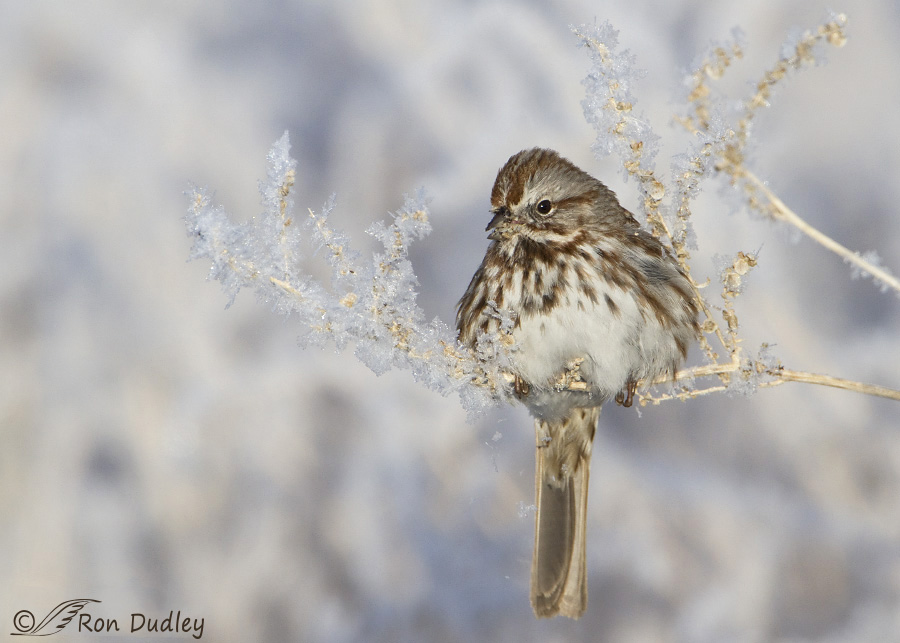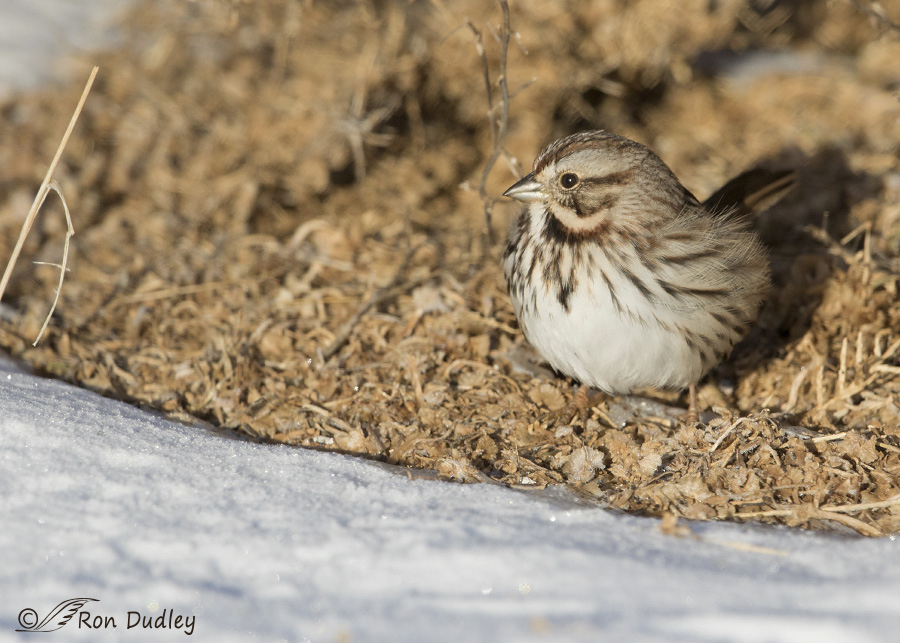Tag: song sparrow
Some Random Recent Birds And Critters
Song Sparrow – After The Bath
A Merry Christmas To All Of My Feathered Photography Friends
The Song Sparrow Versus The Serviceberry
An Acrobatic Song Sparrow Yesterday Morning
Song Sparrow In A Frosty Wonderland
Song Sparrow In A Frosty, Sparkling Wonderland
Sometimes the setting is just as important to the photo as the subject. I believe that to be the case for each image in this series of six.
Yet Another Reason Birds Need Appropriate Habitat
Several Sparrow Species In Frost And Snow
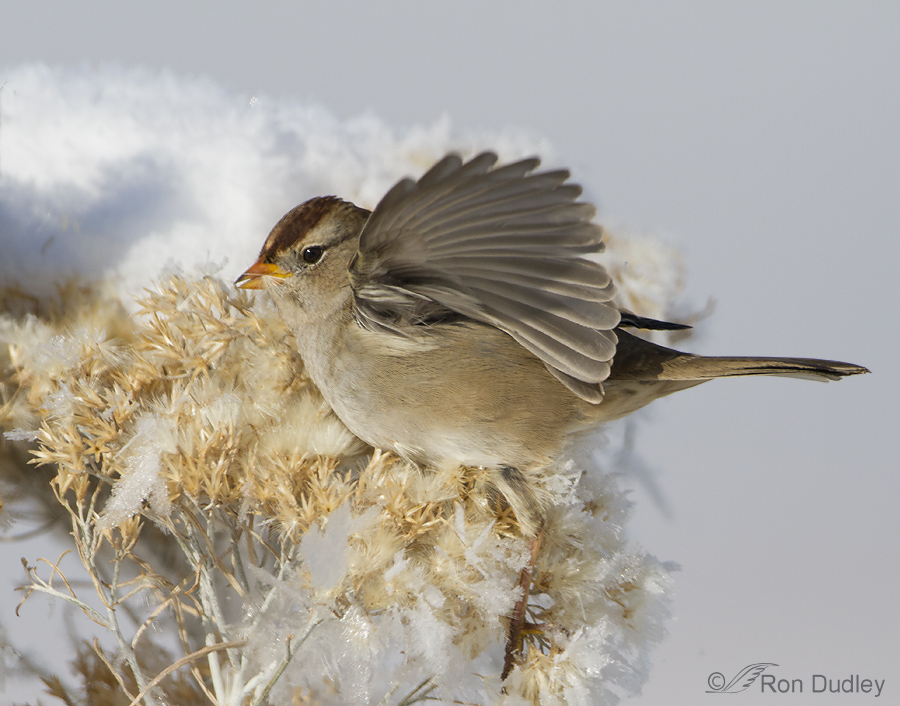
In my area most sparrow species aren’t easy to approach or catch out in the open for most of the year but when it’s very cold and they decide it’s time to begin their communal morning feeding routine they become much braver souls. Earlier this week I photographed three species of sparrows as they harvested seeds from their frost-covered parent plants.
Song Sparrow In A Frosty Wonderland
It’s my natural tendency to avoid public displays of sentiment (another character flaw…) but recently I’ve been reflecting on just how much I enjoy blogging and interacting with my readers. Even though I’ve never actually met most of you, I can’t help but feel that we have become “friends” on some level. And this time of year especially, I think of my friends. Friends usually share at least some common interests and for us it seems to be a mix of birds, nature and/or photography. Many of you are more knowledgeable in those areas than I am and have graciously shared your expertise and experiences with me and others. For that I am grateful. So I wanted to wish each of you the very best this holiday season. I hope you’re with family and loved ones and that your experiences over the next few days will add to your cherished memories down the road. I wish you a safe and joyous holiday season! Ron About the image: The bird is a Song Sparrow, plucking seeds from a hoar frost covered stem on a very cold and magical early morning on the refuge wetlands. You can see frost falling near the tail from the feeding activity.
Just A Shot That I Like… #1
Today I’m starting a new feature on FeatheredPhotography. Typically my posts include multiple images showing a sequence of photos that illustrate bird behaviors, photo techniques, favorite shooting locations and the like. That will not change. But now, in addition I will post a single shot that appeals to me for whatever reason and title the post “Just A Shot That I Like…” and these image posts will be numbered. This is post #1. The photos I choose may be new or from my archives. I’ll mention what I like about the photograph and any significant flaws I think it has. I’ll also include my image techs. My plan is to make one of these posts at least once per week, in addition to my regular posts. 1/2500, f/7.1, ISO 500, 500 f/4, 1.4 tc I found this Song Sparrow early in January 2010 on the coldest day so far that winter. The entire refuge was covered in thick frost – it looked like a magical frosty fairyland all the way to the horizon. The sparrow was puffed up to keep warm and eating ice encased seeds it grabbed from its twiggy perch. I like the frost, the vertical position of the tail, the puffed up squatting pose, the ice crystals falling next to the tail and the whimsical mood of the image. Ron
Fish Eating Northern Harriers
As I’ve mentioned before in this blog, the winter of 2008 was a particularly brutal one in northern Utah. During January and February there was much more snow than usual and it was bitterly cold. During most winters our Northern Harriers rely primarily on voles as a food supply but in 2008 with the voles under the deep crusty snow our harriers were desperate for food. Birds of North America Online provides extensive information on the dietary habits of harriers. It lists small to medium-sized mammals (primarily rodents), birds, reptiles and frogs as harrier food sources, stating further that the diet of harriers during winter in their northern range (which includes northern Utah) consists of voles “almost exclusively”. I can find no mention of harriers eating fish, ever! Each year in early February some of our wetlands managers treat some of our ponds with rotenone (a chemical that prevents oxygen from being absorbed across fish gill membranes) in an effort to control the invasive and damaging carp that do so much damage to the emergent vegetation which is so vital for waterfowl. So, in 2008 for a few weeks, our desperate and starving harriers began to eat fish! In the three winters since then I have never seen harriers eating fish even though the dead carp are always plentiful after the rotenone kill. 1/1250, 1/1000, ISO 500 Many of the carp are brought to the shores or ice surface by Bald Eagles which makes them available to the harriers who generally cannot retrieve them from the water. 1/1250, f/8, ISO…
Some Random Recent Birds And Critters
Song Sparrow – After The Bath
A Merry Christmas To All Of My Feathered Photography Friends
The Song Sparrow Versus The Serviceberry
An Acrobatic Song Sparrow Yesterday Morning
Song Sparrow In A Frosty Wonderland
Song Sparrow In A Frosty, Sparkling Wonderland
Sometimes the setting is just as important to the photo as the subject. I believe that to be the case for each image in this series of six.
Yet Another Reason Birds Need Appropriate Habitat
Several Sparrow Species In Frost And Snow

In my area most sparrow species aren’t easy to approach or catch out in the open for most of the year but when it’s very cold and they decide it’s time to begin their communal morning feeding routine they become much braver souls. Earlier this week I photographed three species of sparrows as they harvested seeds from their frost-covered parent plants.
Song Sparrow In A Frosty Wonderland
It’s my natural tendency to avoid public displays of sentiment (another character flaw…) but recently I’ve been reflecting on just how much I enjoy blogging and interacting with my readers. Even though I’ve never actually met most of you, I can’t help but feel that we have become “friends” on some level. And this time of year especially, I think of my friends. Friends usually share at least some common interests and for us it seems to be a mix of birds, nature and/or photography. Many of you are more knowledgeable in those areas than I am and have graciously shared your expertise and experiences with me and others. For that I am grateful. So I wanted to wish each of you the very best this holiday season. I hope you’re with family and loved ones and that your experiences over the next few days will add to your cherished memories down the road. I wish you a safe and joyous holiday season! Ron About the image: The bird is a Song Sparrow, plucking seeds from a hoar frost covered stem on a very cold and magical early morning on the refuge wetlands. You can see frost falling near the tail from the feeding activity.
Just A Shot That I Like… #1
Today I’m starting a new feature on FeatheredPhotography. Typically my posts include multiple images showing a sequence of photos that illustrate bird behaviors, photo techniques, favorite shooting locations and the like. That will not change. But now, in addition I will post a single shot that appeals to me for whatever reason and title the post “Just A Shot That I Like…” and these image posts will be numbered. This is post #1. The photos I choose may be new or from my archives. I’ll mention what I like about the photograph and any significant flaws I think it has. I’ll also include my image techs. My plan is to make one of these posts at least once per week, in addition to my regular posts. 1/2500, f/7.1, ISO 500, 500 f/4, 1.4 tc I found this Song Sparrow early in January 2010 on the coldest day so far that winter. The entire refuge was covered in thick frost – it looked like a magical frosty fairyland all the way to the horizon. The sparrow was puffed up to keep warm and eating ice encased seeds it grabbed from its twiggy perch. I like the frost, the vertical position of the tail, the puffed up squatting pose, the ice crystals falling next to the tail and the whimsical mood of the image. Ron
Fish Eating Northern Harriers
As I’ve mentioned before in this blog, the winter of 2008 was a particularly brutal one in northern Utah. During January and February there was much more snow than usual and it was bitterly cold. During most winters our Northern Harriers rely primarily on voles as a food supply but in 2008 with the voles under the deep crusty snow our harriers were desperate for food. Birds of North America Online provides extensive information on the dietary habits of harriers. It lists small to medium-sized mammals (primarily rodents), birds, reptiles and frogs as harrier food sources, stating further that the diet of harriers during winter in their northern range (which includes northern Utah) consists of voles “almost exclusively”. I can find no mention of harriers eating fish, ever! Each year in early February some of our wetlands managers treat some of our ponds with rotenone (a chemical that prevents oxygen from being absorbed across fish gill membranes) in an effort to control the invasive and damaging carp that do so much damage to the emergent vegetation which is so vital for waterfowl. So, in 2008 for a few weeks, our desperate and starving harriers began to eat fish! In the three winters since then I have never seen harriers eating fish even though the dead carp are always plentiful after the rotenone kill. 1/1250, 1/1000, ISO 500 Many of the carp are brought to the shores or ice surface by Bald Eagles which makes them available to the harriers who generally cannot retrieve them from the water. 1/1250, f/8, ISO…


